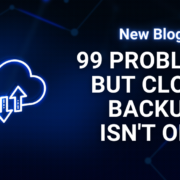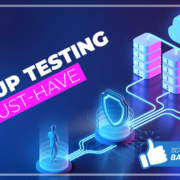Does Your Company Have a Disaster Recovery Plan?
So, what is a disaster recovery plan? A disaster recovery plan, or business continuity plan, is a document that details the steps your business will take to recover from a catastrophic event. Once you make sure that all your employees are safe and sound after a disaster, implementing your disaster recovery plan should be your first order of business.
Disasters are inevitable, and not preparing for them won’t stop them from happening. Loss of power, hardware failures, data corruption, external security breaches, and even unintentional user errors all qualify as disasters. Having a disaster recovery plan in place can benefit your business in many ways including:
- Protecting your business reputation for reliability
- Preventing data loss
- Mitigating the risk of financial loss by keeping revenue-producing systems up and running
The High Cost of Data Loss
Do you understand the real cost of data loss to your business? Not only is data loss one of the most common causes of business disruption, but it can also be one of the costliest. When critical files get wiped out, operations suffer, and downtime begins. Even the loss of a single file can create costly challenges for a business. In the case of a large-scale data loss, like a ransomware attack, the recovery cost can sometimes be insurmountable for smaller companies. Trying to figure out the average cost of data loss can be challenging because it varies depending on the size of the business and the value of the data.
- A 2018 study by Ponemon Institute found that the global average cost of data loss was a staggering $3.6 million, or approximately $141 per data record. However, this research mostly focused on data breaches such as theft of personal user data login information and credit card numbers.
- A leading BC/DR provider estimated that data loss costs U.S. businesses an average of $7,900 per minute during a data center outage.
- A more recent report by Verizon found that “small” instances of data loss (around 100 lost or compromised records) cost businesses an average of $18,120 to $35,730.
- The same study found that large-scale data loss (100+ million records) costs an average of $5 to $15.6 million.
That’s a lot of lost revenue and we haven’t even factored in the cost of downtime. When data is lost, it can cripple your operations, and that’s where the cost starts adding up.
- On average, downtime from data loss incidents like ransomware costs small businesses more than $8,500 per hour, according to 2016 figures from Aberdeen Group.
- Depending on the company’s size, Datto estimates that the costs of downtime can vary from $10,000 per hour to more than $5 million per hour.
What Should a Disaster Recovery Plan Include?
Businesses should begin by taking an inventory of all hardware. Your business continuity plan should include a strategy to ensure that all critical information is being backed up. Identify critical software applications, data, and the hardware required to run them. Prioritize hardware and software restoration. Document the IT disaster recovery plan as a part of your business plan. It’s also a good idea to name a small group of employees as your disaster recovery team.
Take proper steps to ensure their knowledge and understanding of the plan and their designated roles on this team.
Lastly, make sure your team schedules reviews, and the recovery plan is up to date and aligned with your current business objectives.
How Does Disaster Recovery as a Service Work?
Disaster recovery as a service (DRaaS) is a cloud computing and backup service model that uses cloud resources to protect applications and data from the disruption caused by a disaster. It gives your company a total system backup that allows for business continuity in the event of system failure.
If you decide to use an MSP for your business’s disaster recovery service, make sure your MSP is clear on your continuity requirements and expectations. If you need them to be, the MSP can be prepared for a full recovery to ensure business continuity. This includes your company’s data and the entire IT infrastructure.
Data-Tech’s best in class disaster Recovery system called “BUDR” allows your business to protect all the information on their servers, desktops, and laptops. If you are looking for an IT partner to monitor your solution and handle the recovery process smoothly and efficiently, give us a call, we can help!












